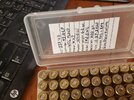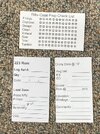Lee Q. Loader
Member
- Joined
- Jan 30, 2018
- Messages
- 444
I need to do a better job keeping track of the number of loads on my brass. I really wish there was a way to mark the brass that wouldn't be removed during tumbling.
I didn't realize until I started shooting a ton of 6.5 Grendel, that this is important so I can keep my rounds as accurate as possible. Prior to the Grendel I have never loaded rifle brass more that 3 or 4 times.
How do you guys keep track? I'm hoping for a bunch of suggestions so I can decide which will work best for me.
I didn't realize until I started shooting a ton of 6.5 Grendel, that this is important so I can keep my rounds as accurate as possible. Prior to the Grendel I have never loaded rifle brass more that 3 or 4 times.
How do you guys keep track? I'm hoping for a bunch of suggestions so I can decide which will work best for me.



